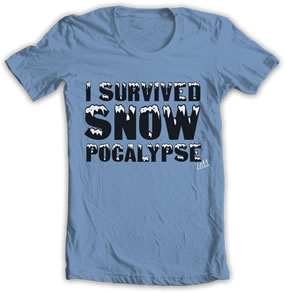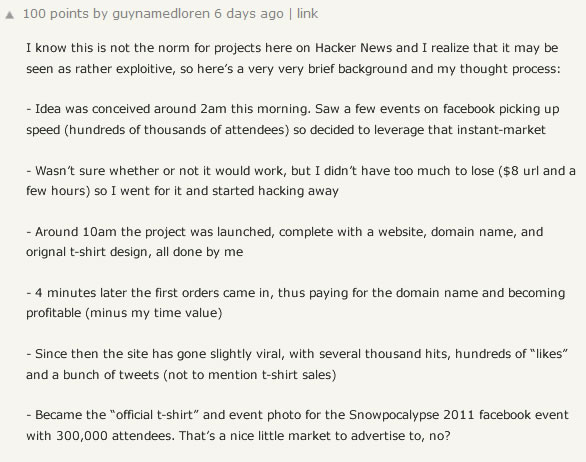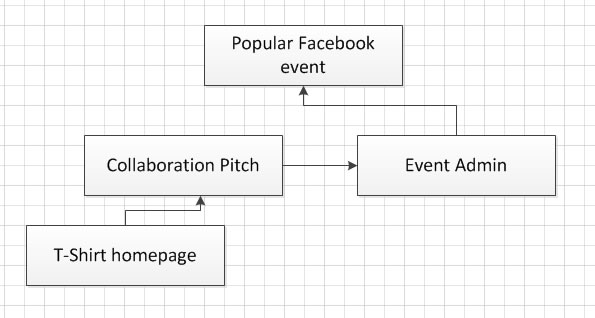How to Scale the 4-Hour Startup

Loren Burton's 4-Hour Startup story has become a bit of a phenomena on HN recently. For two reasons. A) "The 4-Hour Startup" is a brilliant headline. There's a reason why the Timothy Ferris named his book, "The 4-Hour Work Week". It's a tested, proven title that catches peoples attention and they want to learn more. It sells books like crack. Loren inadvertently used a similar headline, but it was optimally tweaked for hackers and startup junkies. "The 4 Hour Startup" is probably the best marketing headline you could possibly post on Hacker News. Thousands of nerds everywhere, me included, were compelled to click that link and learn more.
The second reason why Loren's story has become so popular is that he really does have something here. It's a little business model he stumbled upon by shooting arrows in the dark - and yes, it became profitable in 4 hours.
As a courtesy to Loren, and in the spirit of open business discussion - I'd like elaborate on how he can further develop his strategy; specifically: how to scale it.
First, an assessment of his current strategy. In his own words:

Since his original post, Loren has created a series of follow ups to explain in more detail exactly what he did. In the latest post, The 4-Hour Startup: Marketing It, he reveals that several hours after he began posting links to his T-shirt site on the Snowpocalypse Facebook event page - the Event Admin contacted him asking for royalties. Loren was savvy enough to cut him in on the profits - in return for an official endorsement. And like that, he became the official T-shirt provider for Snowpocalypse 2011.

The key of the strategy
Whether Loren knows this or not, the collaboration he setup with the Event Admin is the most important dynamic of the strategy.
If I were him, I would refine the strategy to make collaborating with the Event Admin top priority.
Loren took the time to setup this T-shirt site for the event; doing all the work. Luckily it perked the interest of the Admin. Next time, he need not rely on luck: contact the Admin direct. Because all work he did setting up the T-Shirt site is leverage can use to perk the Admin's interest and pitch the profit-share collaboration.
In other words, instead of shooting arrows in the dark - he needs to deploy targeted, direct marketing.
What, direct marketing? That's right, marketing. So many entrepreneurs are timid in this regard. If that's you, I suggest you cofound with someone who can take the ball here and run with it. Ever heard of a startup called Groupon? Direct marketing is the foundation of that business. Once they innovated and refined a business model that worked: they sold the shit out it by direct marketing it to businesses everywhere.
Loren has a similar opportunity. He's already discovered a business model that works. It just needs a little refinement now - and once he is getting consistent results - he can scale efforts like mad. Contact every possible popular Event Admin that ever gets posted on Facebook... with a compelling pitch to cut them in on the profits his T-shirt site will generate.
Designing the strategy for scale
What separates poor strategy from good strategy is planned execution based on proven formula. Loren needs to bring together all elements of his strategy and plan out the next stage of execution. Here are such elements.

In this model, the objective of the strategy is to successfully land a collaboration with the Event Admin. The order of tactics are as follows:
- Identify a popular Facebook event
- Create a T-Shirt homepage, design a T-shirt, register domain, upload to the web
- Send a well crafted collaboration pitch to the Event Admin, featuring the preview
If he structures a compelling pitch, there should be no reason why the Event Admin would not be interested. And hence - this is where proven formula is necessary. Here's the biggest secret every marketing guru knows: there is a formula for structuring a one-shot sales pitch. Some have different variations, but the gist of the formula is like this:
A) Grab the reader's attention!
This starts with the title of the first message - AND - that sexy new T-shirt homepage Loren designed. He has to get them highly interested immediately; otherwise the Event Admin won't even bother reading what he has to say.
B) Explain why they should be interested and back it up with facts
Give them the biggest reasons why they should be interested. Ie- "I can sell you 1000 T-Shirts. Here's how...". And back it up with credibility: ideally, a testimonial or case study of the results you've already achieved. How convenient! Snowpocalypse was a big success.
C) Tell them how to respond
The striking blow of his pitch is to tell them exactly how to take action. Seal this deal. It's easy to drop the ball here if the prospect is left guessing as to what to do next. Loren has to make it easy for them to accept the profit share offer. Explaining exactly what he expects in return; specifying what the endorsement will look like. Ideally Loren can get the same kind of placement as he had in the Snowpocalypse event description. Plus maybe even a daily link in the event feed.
T-shirt business in a nutshell
If Loren can create a compelling pitch - send it directly to the Admin of a popular Facebook Event - the chances of striking a collaboration are much higher than simply hoping for the Admin to reach out on their own. And it's a much better approach than simply spamming the event feed with links. With a collaboration in place, the flood gates are open.
Loren has stumbled upon a nice little business model. With a refined strategy and systematic execution of tactics similar to those above, I think he's got something that can be truly scaled.


